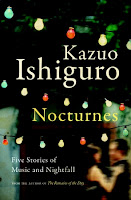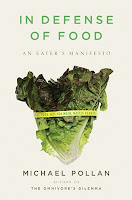 Even before finishing the first story in Kazuo Ishiguro’s Nocturnes: Five Stories of Music and Nightfall, I had a sinking feeling that I shouldn’t have started another book of short stories so soon after finishing Too Much Happiness. Overall, Nocturnes reads and feels like a bridge — not a structure that connects two pieces of land, but that instrumental section in a song that marks a transition. The entire book feels like something Ishiguro has written in between major works. I missed the exacting, perfectly balanced narrative from Never Let Me Go, and had a hard time believing the characters in many of these stories. In places, the dialogue seemed forced, pitched in because it needed to be there and not because organic and/or interesting things were happening within the scene. And two of the middle stories were so, I don’t know, cliched and almost forced, that I almost didn’t finish the book. The last story, as I detail below, was a saving grace.
Even before finishing the first story in Kazuo Ishiguro’s Nocturnes: Five Stories of Music and Nightfall, I had a sinking feeling that I shouldn’t have started another book of short stories so soon after finishing Too Much Happiness. Overall, Nocturnes reads and feels like a bridge — not a structure that connects two pieces of land, but that instrumental section in a song that marks a transition. The entire book feels like something Ishiguro has written in between major works. I missed the exacting, perfectly balanced narrative from Never Let Me Go, and had a hard time believing the characters in many of these stories. In places, the dialogue seemed forced, pitched in because it needed to be there and not because organic and/or interesting things were happening within the scene. And two of the middle stories were so, I don’t know, cliched and almost forced, that I almost didn’t finish the book. The last story, as I detail below, was a saving grace.
Sometimes, stories about music and the people who play and/or create it, never capture the true essence of the experience. You always feel as though it’s not real — the bands are made up, the musicians are made up, even when the author uses actual music to ground the story in some form of reality. In a sense, a lot of these stories read like those “ripped from the headlines” episodes of Law and Order where they take a real scene, Puff Daddy and J-Lo involved in a shoot out at a club, use no-name actors and tack on a murder to take the whole drama up a notch. Overall, this collection felt a bit like that, not utterly authentic, and I was disappointed because I firmly believe Ishiguro to be one of the world’s best living writers.
The first story, “Crooner,” follows a young guitar player who has emigrated from an Eastern block country to Italy where he’s making a living. He meets a very famous singer, a kind of “great one” who came up in the days when crooning lead to fortunes being made in Vegas at a time when the original Ocean’s Eleven was released into theatres. The aging crooner hires the young guitarist to accompany him as he serenades his wife. The performance, for many reasons is bittersweet, but the contract between the young and the old, their very different lives, what the crooner meant to the young man (who grew up with his mother listening to all of his albums), is poignant. Things are never as they seem, lives are never what they appear, and music doesn’t always have the meaning it suggests.
The other three, and especially “Come Rain or Come Shine,” are somewhat forgettable. There’s a ridiculous element to that particular story (“Come Rain or Come Shine”) that I didn’t find believable, and despite liking the main character, a fellow who teaches English in Spain (who’s kind of trapped in this transitory life), not a single secondary moved beyond a level of caricature. The tenuous connection to music wasn’t enough to keep me interested in the mess the this fellow finds himself in as he visits two, married, university friends. Yet, even when I don’t find the situation or the characters particularly engaging, I can still respect Ishiguro’s talent — a bad Ishiguro story is still better than most. There just didn’t seem to be enough emotional consequence in any of the stories to keep me interested throughout the read.
The other story worth mentioning, the very last piece in the book, “Cellists,” that was, by far, my favourite of the five. A young cellist starting me make his way in the world finds himself a teacher in an American tourist. They develop a deep and lasting teacher/student relationship over the course of a summer. She’s running away from a relationship she can’t quite decide if she wants to be in or not, and he’s trying desperately to live up to both his talent and his potential. They each take something different from one another: she believes she’s a genius, like him, and he believes his work is getting better simply through the power of her words, her explanations of what’s wrong with his playing.
The narrator of this story, a bandmate and friend of the cellist, tells the story with a detached sense of wonder, in a way — he sees the cellist years later, better dressed, nicely groomed, and is reminded of the strange summer they spent together. The last paragraph of the story might just be the best of the entire book — it’s pitch perfect in its assessment of both what happened to the cellist and how potential, or any kind of gift really, can easily slip away. It was utterly, heartbreakingly, authentic.
READING CHALLENGES: Ishiguro was born in Japan (even though he’s lived in the UK since he was 5 or something), so I’m counting it as Around the World in 52 Books, which might just bring me to, oh, five books read for that challenge this year. Pathetic!
 Carrying forth with my “I should read more nonfiction. I’ll do it in January” mentality, I finished Michael Pollan’s excellent In Defense of Food this week. I know Foer’s critical of Pollan’s approach in Eating Animals, but I still find him to be the most logical, engaging food/environmental writer (and I don’t read widely, sorry!) that I’ve read in years.
Carrying forth with my “I should read more nonfiction. I’ll do it in January” mentality, I finished Michael Pollan’s excellent In Defense of Food this week. I know Foer’s critical of Pollan’s approach in Eating Animals, but I still find him to be the most logical, engaging food/environmental writer (and I don’t read widely, sorry!) that I’ve read in years.






